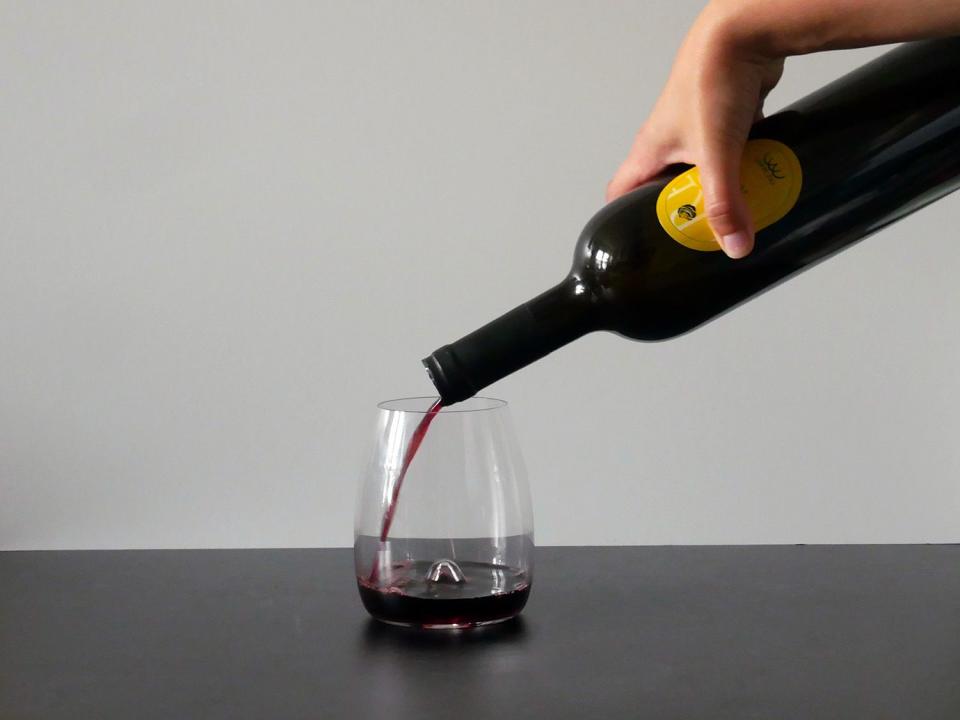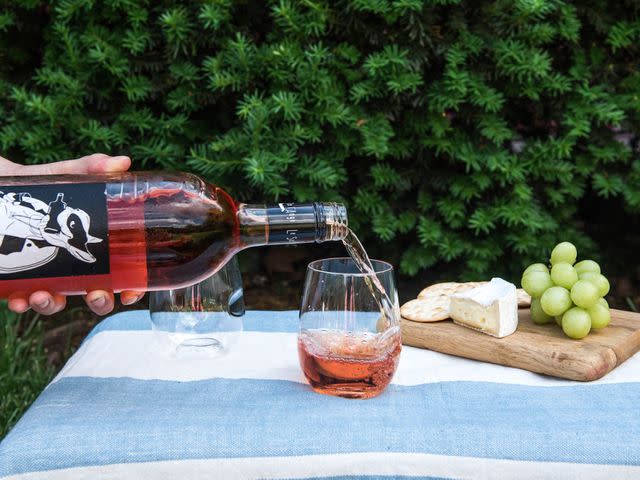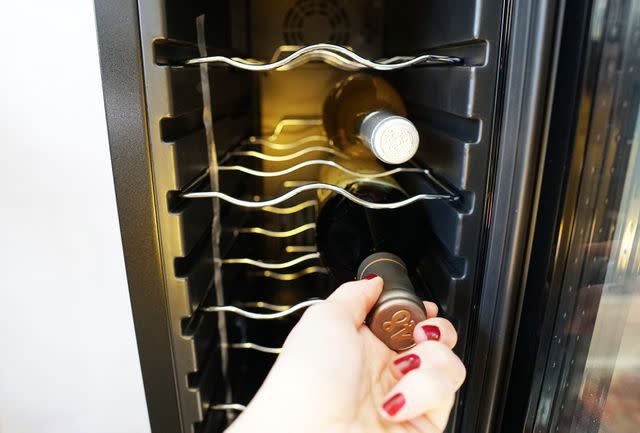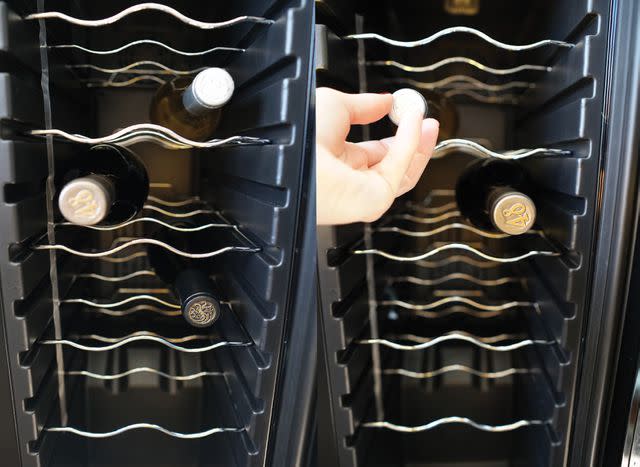Everything You Need to Know About Wine Fridges
Dotdash Meredith and Yahoo Inc. may earn commission or revenue on some items through the links below.
Plus, which ones you should get—according to experts.

Serious Eats / Grace Kelly
Wine is constantly evolving. Living organisms and the exchange of oxygen through porous, natural cork allow wine to continue to breathe and develop, even after it’s in the bottle. This is why the flavor of many wines improves with age. There’s one caveat here—and it’s a big one. For a wine to age well, it must be stored properly.
Excess exposure to light and heat during storage can ruin a bottle of wine, and investing in a wine fridge is one way to avoid the tragedy of a damaged Bordeaux. Even if you don’t intend to age or store wine for a long period of time at home, a wine fridge can be a useful way to keep wine at the proper drinking temperature and free up space in your main refrigerator.
Why Temperature Matters When It Comes to Wine

Serious Eats / Liz Clayman
The temperature of a bottle makes a huge difference in how we perceive its flavor. When we consume wine, we’re using our sense of taste and smell. Our tongue detects basic flavors like salty, sweet, and bitter. Our sense of smell fills in the blanks—it picks up on subtle notes like fruit, spices, or herbs. Temperature affects both of these elements.
Our taste buds are extremely sensitive to heat and cold, as explained by America’s Test Kitchen. Cold temperatures cause tastebuds to shrink—making them less receptive to flavor. Marie Tribouilloy, the owner of Forêt Wines, describes this phenomenon simply, saying “Excess cold will numb your tongue.” A wine that’s consumed too cold will appear muted and flavorless. To observe the power of temperature, Tribouilloy encourages wine lovers to try this experiment at home: “Take a bottle of white wine out of the [kitchen] fridge and taste it right away. Then, let it warm up for 30 minutes and taste it again.”

Serious Eats / Riddley Gemperlein-Schirm
Temperature also affects the wine itself on a molecular level. At high temperatures, molecules in the liquid are moving around quickly and freely. This means more of them escape into the air where we can experience their aroma. In wine, these are referred to as volatile aromatic compounds. The warmer the wine, the more of these compounds reach our noses. At a certain point, this can become a negative. Scott Carney, Master Sommelier and Dean of Wine Studies at the Institute of Culinary Education, describes the relationship between heat and wine, saying “As it warms up, it all becomes more apparent—all the good, all the bad, and all the everything.” Wines that are consumed too warm are more likely to reveal their flaws and may seem overripe or flabby.
Carney refers to the ideal temperature as the one that “flatters the wine.” The recommended serving temperature for red wines is slightly below room temperature, between 55ºF and 65ºF. In the wine world, this is commonly referred to as cellar temperature. The ideal temperature for white wines is between 45ºF and 50ºF. This is considerably warmer than the temperature of the average kitchen refrigerator, which is generally 40ºF or below. A dedicated wine fridge is an easy way to hold wine at the proper temperature while simultaneously protecting it from the elements.
The Criteria: What to Look for in a Wine Fridge

Serious Eats / Riddley Gemperlein-Schirm
Whether you’re aging your own wine, or just looking to keep a few bottles cold, these are the factors that wine enthusiasts of every level should consider when looking for a wine fridge.
Space
Space is a major consideration when investing in a new appliance. Consider the available space in your home, as well as how many bottles you’d like to store. For the majority of wine enthusiasts, an under-the-counter wine fridge will offer more than enough space. If you refer to the wines in your home as a collection, you’re probably going to want something bigger.
Under-the-counter models can hold around 30 to 45 bottles. For serious collectors, larger fridges are available in the form of 48-inch wide lowboys or tall, vertical models that can store hundreds of bottles. When evaluating space, Carney recommends taking the listed capacity with a grain of salt. He explains that manufacturers calculate storage space using standard Bordeaux bottles. Although they hold the same amount of liquid, Bordeaux bottles are narrower than classic Burgundy, Zinfandel, or Chardonnay bottles.
Dual-Zone Temperature Control
Many wine fridges are divided into sections with individual temperature control— allowing you to store wines at two different temperatures. Dual zones can be used to simultaneously store red and white wines at their optimal temperatures or to separate the bottles you’re cellaring from the bottles you intend to consume immediately.
UV Light Protection
Exposure to sunlight can damage wines over time, creating a flaw called light strike. To protect your wines from harmful UV rays, look for a wine fridge with a double insulated glass or solid door.
How to Use a Wine Fridge
To extend the life of your wine fridge, Carney emphasizes the importance of proper installation. The less stress you place on the compressor, the longer the product will last. Avoid placing your wine fridge flush against a wall, where the compressor will have to work overtime to exchange air. Keeping your wine fridge in a cooler area of your home, like a basement, will also limit how hard the compressor has to work.
After installation, set the fridge temperature and load in your wine. Wine bottles should always be stored on their side to prevent the cork from drying out. The racks in our favorite wine fridges are designed so that the bottles can be laid down horizontally. Most models will have notches on the shelves to hold individual bottles in place. Don’t overfill the shelves; one extra chilled bottle isn’t worth the risk of a collapse.
Which Wine Fridge Should You Buy?
The Best Wine Fridge for Large Spaces : BODEGA Wine Cooler Refrigerator 24 Inch

If you’re willing to dedicate a lot of space to a wine fridge, consider a full-sized product like the Bodega 70-inch DualZone Wine Chiller. This model can store up to 174 bottles. In addition to DualZones and double-paneled glass doors, this Bodega wine fridge features front-facing ventilation. That means that it can be installed against a wall without placing extra stress on the compressor. And while it is expensive, this correlates to its size and features.
The Best Compact Wine Fridge: Wine Enthusiast 18-Bottle Slimline Dual Zone Wine Cooler with Upright Bottle Storage

For smaller spaces, we love the Wine Enthusiast 18-Bottle Slimline Dual Zone Wine Cooler. This narrow model offers premium features with a super small footprint. Wine Enthusiast is a trusted name in wine products with an excellent reputation for customer service and a warranty available on most items.
The Best Slightly Larger Budget-Friendly Wine Fridge: Yeego Wine Fridge,15 Inch Wine Cooler

Yeego offers a less expensive option that still stores a full case of wine. Their 15-inch wine cooler can hold up to 33 bottles. Double-paned glass doors keep the temperature stable, and a one-year warranty protects your investment. This is a single-zone wine fridge. Although that somewhat limits storage options, it also reduces stress on the compressor, which may prolong the life of the product.
FAQs
What’s the best temperature for wine?
The ideal serving temperature depends on the style of wine. Sparkling wines should be served cold, between 43°F and 47°F. White wines should be served chilled, between 45ºF and 50ºF. Red wines should be served at cellar temperature, between 55ºF and 65ºF.
Should you put wine in the fridge?
Storing wines long-term in the refrigerator isn’t recommended. The dry air in a refrigerator can dry out a wine cork, exposing your wine to oxygen, and diminishing its lifespan.
If you don’t have a wine fridge, you can use the refrigerator to chill your bottles. For white wines, place them in the refrigerator the day before, then take them out to warm up for about 15 minutes before serving. Store red wines at room temperature, then place them in the refrigerator for about 15 minutes before serving to add a slight chill.
Can you put red wine in a wine fridge?
Yes! Some wine fridges have dual zones so that red and white wines can both be stored at optimal temperatures. For red wines, adjust the temperature to somewhere between 60ºF-65ºF.

